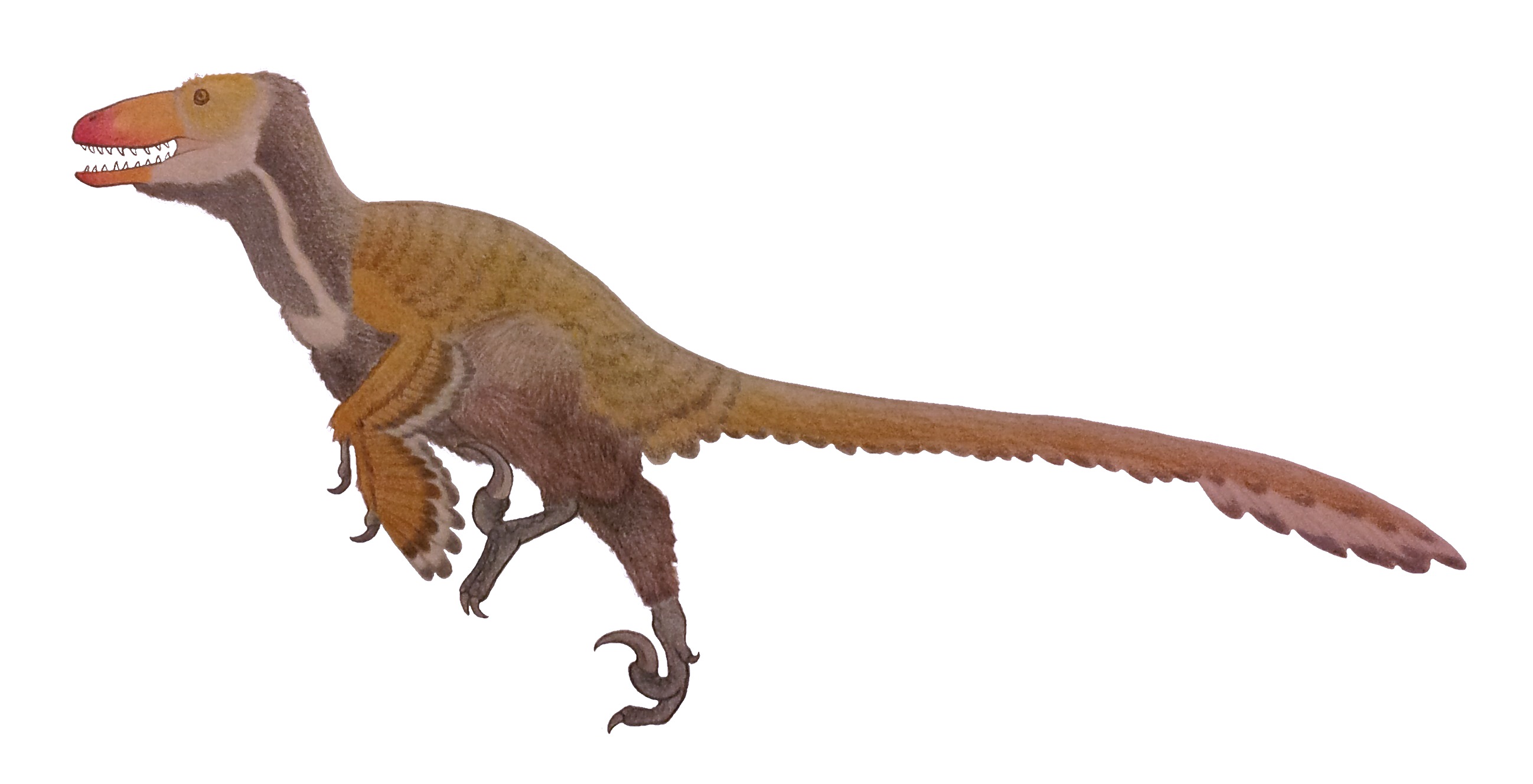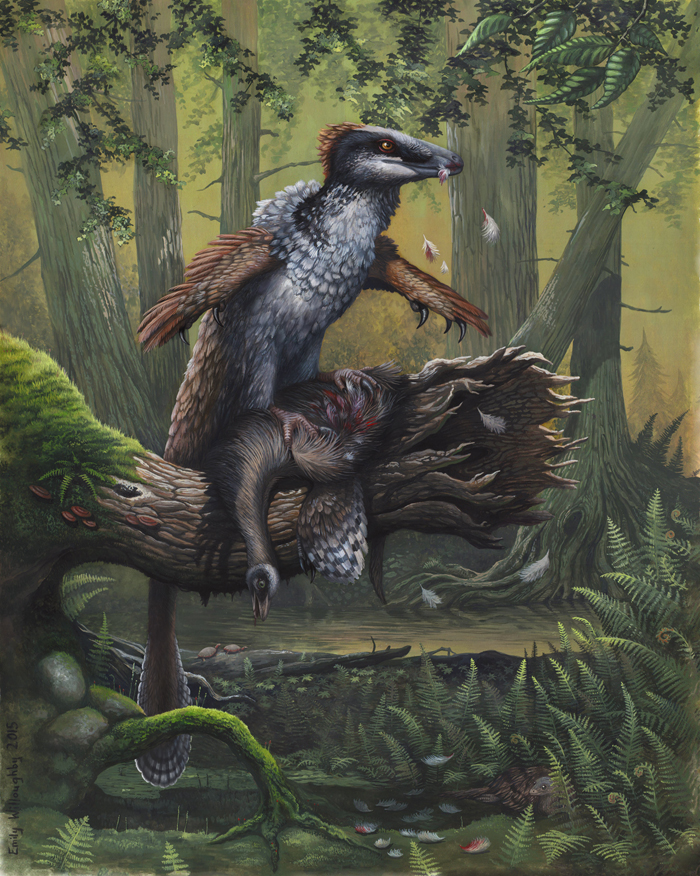 |
| Once again, it's time to look at the past year's dinosaur discoveries! |
It is: 2 days till New Year's
It is: 6 days till My Birthday
It is: 19 days till Martin Luther King Jr. Day
In the Spotlight:
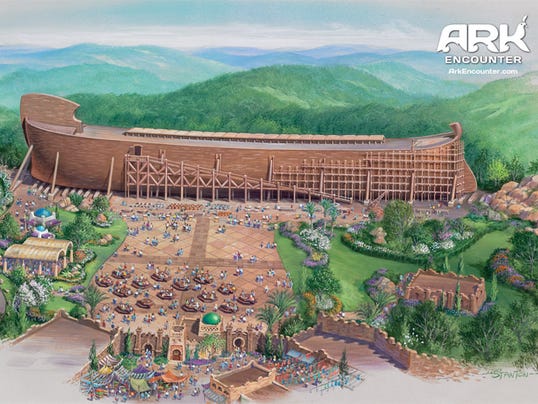 |
| The Ark Encounter, opening July 7th, 2016. (Property of Answers in Genesis) |
In addition to the many other things we have to look forward to next year, I'd like to draw your attention to a new “theme park” opening on July 7th, 2016 called “Ark Encounter”. In case you're one of the individuals who's unaware, the Ark Encounter is a subdivision of the creationist company Answers in Genesis (I'm a BIG fan of their work...in case you somehow haven't noticed); not too long ago they opened the Creation Museum in Kentucky. Now, not far from the Creation Museum, AiG is constructing a life-size wooden ark, modeled after the one Noah built in Genesis 6-7. It's going to be 510 feet long, 51 feet tall and 84 feet wide when complete! While the real Noah's ark was technically a floating zoo, perfectly designed to stay afloat on the high global seas, the Ark Encounter vessel will be so much more. The best I can describe it is as a museum inside of an ark, it's going to feature many different kinds of animals depicted as they might have looked on Noah's ark, and several dioramas and exhibits talking about how we know the global Flood of Noah's time happened, the Ice Age, the wickedness of the pre-Flood world and so on. But don't take my word for it, check out a video they recently released talking about what kinds of exhibits they'll have inside the ark:
When you're finished with that video, please go to their newly-designed website talking all about the Ark Encounter, and even a little bit about what kinds of animals they'll feature and so much more: www.arkencounter.org.
Topic of the Week by Christian Ryan2015 has been a great year for dinosaur lovers. We've had more dinosaur movies/documentaries than you can shake a stick at (e.g. T. rex Autopsy, Dino Death Match, Dinosaur Britain, The Good Dinosaur and, the biggest of them all, Jurassic World). But not only have there been a multitude of dinosaur documentaries/movies, we've also had a great year for dinosaur discoveries. Below is a list of just a few of the newest species of dinosaurs discovered and new research on dinosaurs discovered in previous years.
New Dinosaur Species of 2015
Carnufex
 |
| Carnufex could swim after you in the water, and run after you on land! (Image Credits) |
Chilesaurus
 |
| Chilesaurus was an herbivorous theropod. (Image Credit: Gabriel Lio) |
Dakotaraptor
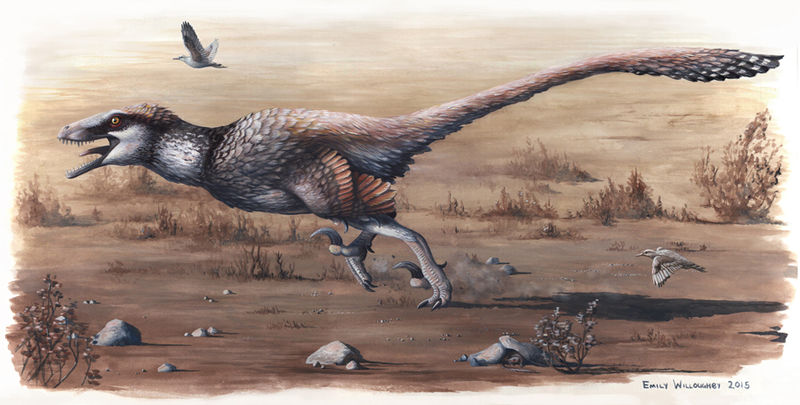 |
| Dakotaraptor was one of the most dangerous dinosaurs ever to walk the earth. (Image Credit: Emily Willoughby) |
To read more about Dakotaraptor, please see my full article.
Hualianceratops
 |
| Hualianceratops was a smaller relative of Triceratops. (Image Credits:PortiaSloanRollings) |
Triceratops is the most popular member of the ceratopsian baramin (“created kind”), but cousins of this 10-ton herbivore come in all shapes and sizes, from another 2015 discovery, the extra-frilled Regaliceratops which grew over 15 feet long, to the spaniel-sized Hualianceratops. This ceratopsian made its home in what is now China's Gobi Desert; at the time, the area was certainly much more forested than it is today. This Jurassic ecosystem boasted a wide range of dinosaurs, from long-necked sauropods, to the predatory Guanlong, a small raptor-like tyrannosaur described in 2006. Unlike its larger relatives, Hualianceratops lacked horns and an elaborate frill and it walked on two legs rather than four.
Kunbarrasaurus
 |
| Kunbarrasaurus was thought to belong to the genus Minmi until very recently. (Image Credits: Australian Geographic) |
Ankylosaurs are a group of dinosaurs known for being covered in tough armor plates. These plates cover the entire upper half of the animal – even the eyelids are hardened! Some ankylosaurs even had clubs on the ends of their tails. Kunbarrasaurus is a newly discovered ankylosaur from Queensland, Australia. Actually, Kunbarrasaurus was officially dug out of the ground in 1989, but it was thought to be a genus of ankylosaur already discovered, called Minmi (a previous record-holder for the shortest dinosaur name). But recently, scientists found that Kunbarrasaurus' fossils have enough distinctions to make it a different genus.
Qijanglong
 |
| Qijanglong had a neck half as long as its entire body! (Image Credits: Lida Xing) |
Morelladon
 |
| Morelladon was a sail-backed relative of Iguanodon. (Image Credits: Carlos de Miguel Chaves) |
Dinosaurs just get weirder and weirder, don't they? (And we're not even to the weirdest one on the list yet!) Morelladon was an iguanodont dinosaur with a sail on its back. Scientists aren't sure why this Spanish herbivore had this feature; it's likely however that the sail was used for display purposes. Morelladon wasn't the only dinosaur to possess a sail: the fish-eating spinosaurs and another iguanodont called Ouranosaurus also had sails. However, perhaps the most elaborate sail of all the dinosaurs belonged to Spinosaurus – its sail stood over six feet tall!
Phosphorosaurus
 |
| Phosphorosaurus is not a dinosaur, but a marine lizard of the mosasaur family. (Image Credits: Tatsuya Shinmuru) |
Mosasaurs were marine lizards that were very similar to modern monitor lizards. They got a burst of popularity when Mosasaurus (the type species of the mosasaur family) ate Jaws for lunch in the Mosasaurus Feeding Show. Unlike the monster, 60-foot long Mosasaurus, the newly-discovered Phosphorosaurus was not an apex predator of the pre-Flood seas. It was only 10 feet long and fed on fish and squid-like animals. Paleontologists believe Phosphorosaurus may have hunted at night because it had large, forward-facing eyes, unlike other mosasaurs. This means it probably would have been capable of night-vision. Phosphorosaurus was discovered in Japan.
Ugrunaaluk
 |
| Ugrunaaluk was misidentified as Edmontosaurus for decades. (Image Credits: James Havens) |
Diplodocus. Stegosaurus. Parasaurolophus. You thought those names were hard to pronounce! But you haven't seen a hard-to-pronounce dinosaur name until you've tried to say Ugrunaaluk (Ug-ru-naa-luk). It took me forever to learn how to pronounce this one! This dinosaur was a member of the hadrosaur (duck-billed dinosaur) family and if its name sounds rather unusual for a dinosaur, that's because it isn't derived from the Greek or Latin like most dinosaur names are, but the Inupiat language reflecting where the dinosaur was found – northern Alaska; Ugrunaaluk means “ancient grazer”. Pretty much since the 1980's, scientists have unearthed over six thousand hadrosaur fossils from Alaska. At first, they were believed to belong to a type of lambeosaurine hadrosaur (a hadrosaur with a bony crest). But after more examination, the fossils were classified as Edmontosaurus fossils. However, in 2014 scientists continued to study the fossils and found out something shocking – they weren't Edmontosaurus fossils, or the fossils from any other known hadrosaur, but a new species! As if this weren't surprising enough, many of Ungrunaaluk bones aren't actually fossilized – these are “fresh” dinosaur bones! You would think that this would be a revolutionary discovery, but alas it has been ignored by most of the media or “shoved under the rug”. This is likely because it would further jeopardize the idea that the dinosaur bones are millions of years old and make the biblical view that these dinosaurs were buried in the waters of the Genesis Flood the only logical explanation.
Yi
 |
| Yi qi and similar weirdos are from the strange family scansoriopterygidae. (Image Credits: Dinostar) |
Dinosaur names are known to be long, tongue-twisty and hard to pronounce, especially names like Ugrunaaluk. So try this one for size: Yi. Yes, that's actually the name of a dinosaur, and it was almost as weird as its name. Its full name (genus and species name) is Yi qi (pronounced “ee-chee”) and it means “strange wing”. So what makes Yi qi stand out? Firstly, this Chinese dinosaur is small, about the size of a pigeon. It also boasts the smallest name of any dinosaur (beating previous record-holders, Mei and Minmi). The most amazing thing about Yi qi though is that it possessed a special membrane supported by a bony rod protruding from its wrist. It was the first, and so far only, dinosaur discovered with bat-like wings! Now it couldn't fly like bats or pterosaurs (flying reptiles with similar wing membranes); instead it was probably a glider, moving from tree to tree, using its “wings” to glide long distances between them. Evolutionists call an instance where a creature has similar features to another unrelated creature “convergent evolution” (strangely, when the same finds occur in creatures they claim are related, it is presented as evidence that the creatures evolved). Instead, Yi qi's bat-like wings point to a Designer who created both Yi qi's baramin and bats. Another interesting thing about Yi qi's discovery is that scientists found melanosomes, which contain pigment cells. By looking at these, scientists were able to tell that Yi qi glided through the forest in a shade of black, with yellow-brown coloration on its head and wing membranes.
Zhenyuanlong
 |
| Zhenyuanlong is from the same ecosystem as many other well-known so-called "feathered dinosaurs", including Microraptor, Sinosauropteryx and Sinornithosaurus. |
While being touted as positive proof that it's supposed cousin Velociraptor was a feathery feign, Zhenyuanlong is hardly the proof dino-to-bird theorists are looking for. What was actually discovered in China's Liaoning Province? Well, scientists recently described a five-foot-long, nearly complete skeleton complete with fossilized feathers. Contrary to popular opinion, aside from the tremendous evidence against the idea that theropod dinosaurs evolved into birds, Zhenyuanlong cannot act as an aid to the theory, as it has several features that identify this creature as a bird, and not a dinosaur; certainly no cousin to Velociraptor. To see why, please see this article by Answers in Genesis. So what of Zhenyuanlong's clawed wings, long bony tail and sharp dinosaur-like teeth? Well, like many other now-extinct birds, like Alexornis, Archaeopteryx, Microraptor, Hesperornis and Ichthyornis, Zhenyuanlong was a species of predatory bird, unique to the pre-Flood world. Zhenyuanlong must have been a terror to smaller creatures in the forest it lived in.
To read more about why dinosaurs could not evolve into birds, please see this article.
New Research of 2015
Brontosaurus
 |
| Brontosaurus, once considered synonymous to Apatosaurus, might make a comeback! (Photo Credits: Davide Bonadonna) |
Since the early 20th century, scientists have thought that sauropod Brontosaurus was the same species as the closely related Apatosaurus. Therefore, the name invented first – Apatosaurus – was kept and Brontosaurus was dropped, until a 2014-2015 study, that is. A group of scientists was able to conclude that after reevaluating the fossils of both dinosaurs, that Brontosaurus was distinct enough to return as its own species. See an article about the discovery here.
Cave Lion
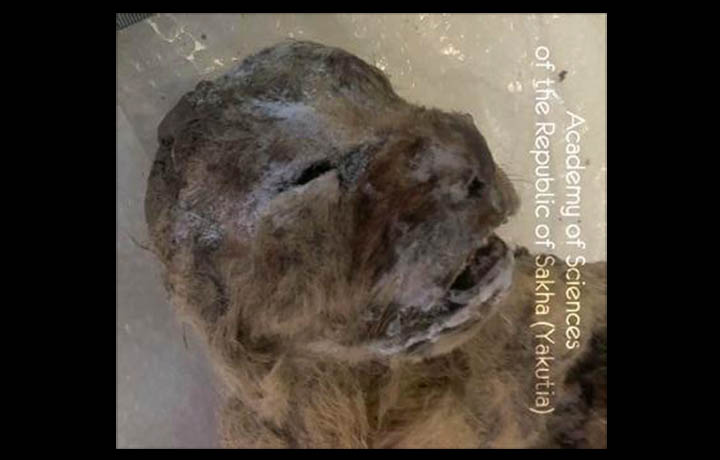 |
| This cave lion cub is one of the best preserved extinct cats ever found. (Image Credits: Academy of Sciences in Yakutia) |
While clearly not a dinosaur discovery, I thought this was worthy to bring up. A few months ago, scientists reported on the discovery of two cave lion cubs that were found frozen in Russian permafrost. Cave lions were a subspecies of the modern lion that lived throughout Europe and Asia during the Ice Age. This discovery is rather amazing because the cubs are the best preserved extinct cats ever found. Until now, we have only had cave lion skeletons and paintings of these cats by Ice Age people to know what they looked like.
For more on this discovery, go here.
Well, that wraps up my blogging until next year. To everyone out there:
HAVE A HAPPY NEW YEAR!
See you in 2016!
Disclaimer: The images above are not my own unless otherwise indicated. If you own one of the above images and want it removed, please notify me via my email.
References:
www.sci-news.com/paleontology/science-carnufex-carolinensis-new-prehistoric-crocodile-north-carolina-02617
www.birmingham.ac.uk/news/latest/2015/04/Chilesaurus
www.icr.org/article/new-fossil-dubbed-platypus-dinosaur
www.livescience.com/53039-new-jurassic-horned-dinosaur
www.sci-news.com/paleontology/kunbarrasaurus-ieversi-new-armored-dinosaur-species-03507
www.earthsky.org/earth/long-necked-dinosaur-roamed-china-160-million-years-ago
www.sci-news.com/paleontology/phosphorosaurus-ponpetelegans-new-mosasaur-species-03498.html
www.news.discovery.com/animals/dinosaurs/new-dinosaur-had-a-sail-on-its-back-151216
www.wikipedia.org/wiki/Ugrunaaluk
www.prehistoric-wildlife.com/species/u/ugrunaaluk
www.creation.com/unpermineralized
www.prehistoric-wildlife.com/species/y/yi
www.phenomena.nationalgeographic.com/2015/04/29/chinese-dinosaur-had-bat-like-wings-and-feathers
www.answersingenesis.org/dinosaurs/feathers/what-if-dinosaurs-really-had-feathers


